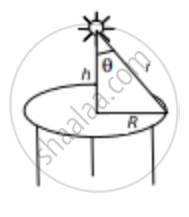Advertisements
Advertisements
Question
A student is studying a book placed near the edge of a circular table of radius R. A point source of light is suspended directly above the centre of the table. What should be the height of the source above the table so as to produce maximum illuminance at the position of the book?
Solution

Let the height of the source be h and the luminous intensity in the normal direction be I0.
So, illuminance on the book (E) is given by,
\[E = \frac{I_0 \cos\theta}{r^2}\]
From the figure we get
Cosθ = \[\frac{h}{r}\]
On substituting the value of Cosθ, we get
\[E = \frac{I_0 h}{r^3}\]
But r = \[\sqrt{R^2 + h^2}\]
\[\therefore E=\frac{I_0 h}{\left( r^2 + h^2 \right)^\frac{3}{2}}\]
For maximum illuminance,
\[\frac{dE}{dH} = 0\]
\[\frac{dE}{dH} = \frac{I_0 \left[ \left( R^2 + h^2 \right)^\frac{3}{2} - \frac{3}{2}h \times \left( R^2 + h^2 \right)^\frac{1}{2} \times 2h \right]}{\left( R^2 + h^2 \right)^3} = 0\]
\[\Rightarrow \left( R^2 + h^2 \right)^\frac{1}{2} \left[ R^2 + h^2 - 3 h^2 \right] = 0\]
\[ \Rightarrow R^2 - 2 h^2 = 0\]
\[ \Rightarrow h = \frac{R}{\sqrt{2}}\]
APPEARS IN
RELATED QUESTIONS
The luminous flux of a 1 W sodium vapour lamp is more than that of a 10 kW source of ultraviolet radiation. Comment.
The sun is less bright at morning and evening as compared to at noon although its distance from the observer is almost the same Why?
Three light sources A, B and C emit equal amount of radiant energy per unit time. The wavelengths emitted by the three source are 450 nm, 555 nm and 700 nm respectively. The brightness sensed by an eye for the sources are XA, XB and XC respectively. Then, ________ .
An electric bulb is hanging over a table at a height of 1 m above it. The illuminance on the table directly below the bulb is 40 lux. The illuminance at a point on the table 1 m away from the first point will be about ___________ .
The intensity produced by a long cylindrical light source at a small distance r from the source is proportional to _________ .
A photographic plate is placed directly in front of a small diffused source in the shape of a circular disc. It takes 12s to get a good exposure. If the source is rotated by 60° about one of its diameter, the time needed to get the same exposure will be ___________ .
A point source of light moves in a straight line parallel to a plane table. Consider a small portion of the table directly below the line of movement of the source. The illuminance at this portion varies with its distance r from the source as ___________ .
The brightness-producing capacity of a source
(a) does not depend on its power
(b) does not depend on the wavelength emitted
(c) depends on its power
(d) depends on the wavelength emitted
A room is illuminated by an extended source. The illuminance at a particular portion of a wall can be increased by
(a) moving the source
(b) rotating the source
(c) bringing some mirrors in proper positions
(d) changing the colour of the source.
Mark the correct options.
(a) The luminous efficiency of a monochromatic source is always greater than that of a white light source of same power.
(b) The luminous efficiency of a monochromatic source of wavelength 555 nm is always greater than that of a white light source of same power.
(c) The illuminating power of a monochromatic source of wavelength 555 nm is always greater than that of a white light source of same power.
(d) The illuminating power of a monochromatic source is always greater than that of a white light source of same power.
Mark out the correct options.
(a) Luminous flux and radiant flux have same dimensions.
(b) Luminous flux and luminous intensity have same dimensions.
(c) Radiant flux and power have same dimensions.
(d) Relative luminosity is a dimensionless quantity.
A source emits 45 joules of energy in 15 s. What is the radiant flux of the source?
A photographic plate records sufficiently intense lines when it is exposed for 12 s to a source of 10 W. How long should it be exposed to a 12 W source radiating the light of same colour to get equally intense lines?
A point source emitting 628 lumen of luminous flux uniformly in all directions is placed at the origin. Calculate the illuminance on a small area placed at (1.0 m, 0, 0) in such a way that the normal to the area makes an angle of 37° with the X-axis.
The illuminance of a small area changes from 900 lumen m−2 to 400 lumen m−2 when it is shifted along its normal by 10 cm. Assuming that it is illuminated by a point source placed on the normal, find the distance between the source and the area in the original position.
Light from a point source falls on a small area placed perpendicular to the incident light. If the area is rotated about the incident light by an angle of 60°, by what fraction will the illuminance change?
An electric lamp and a candle produce equal illuminance at a photometer screen when they are placed at 80 cm and 20 cm from the screen respectively. The lamp is now covered with a thin paper which transmits 49% of the luminous flux. By what distance should the lamp be moved to balance the intensities at the screen again?
Choose the correct answer from given options
Photo diodes are used to detect
Light rays from a point object ______.
Light travels through a glass plate of thickness t and having a refractive index μ. If c is the velocity of light in vacuum, the time taken by the light to travel this thickness of glass is ______.
